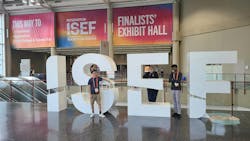ISEF: Where You Can Find Our Future Scientists and Engineers
What you’ll learn:
- What is the Society for Science?
- Why the International Science and Engineering Fair (ISEF) is important.
- Why finding scientists and engineers may be much harder in the future.
Today (Wed., May 14, 2025), judges are looking at projects from thousands of the top students across the globe at the 2025 Regeneron International Science and Engineering Fair (ISEF) hosted by the Society for Science.
This will be the first year in many decades that I've not attended ISEF. I had the honor of being the chaperone for the grand prize winners of our local Mercer Science and Engineering Fair (MSEF) each year. I'm still involved with MSEF, but have handed over the management of the fair to other enthusiastic scientists and engineers who are continuing its long tradition of supporting STEM education.
While I still think science and engineering are great and valuable careers, I'm less sure of there being more people in these fields in the future, given the current trends in the United States when it comes to science and engineering.
What is the Society for Science?
The Society for Science has been around a bit longer than MSEF, which is over 70 years old.
“Founded as Science Service in 1921, the Society for Science has been dedicated to expanding scientific literacy, access to STEM education and scientific research for more than 100 years. As a nonprofit 501(c)(3) membership organization, our mission promotes the understanding and appreciation of science and the vital role it plays in human advancement: to inform, educate, and inspire. We are best known for our award-winning magazine, Science News, our world class science research competitions and our STEM Outreach programs making sure that every young person can strive to become an engineer or scientist. Thanks to guidance from our Board of Trustees, Honorary Board and National Leadership Council we continue to achieve our mission through our magazines, competitions and programs.”
The Society annually hosts these worldwide competitions:
- Regeneron International Science and Engineering Fair (ISEF)
- Thermo Fisher Junior Innovators Challenge (JIC)
- Regeneron Science Talent Search
Any student can participate in the Regeneron Science Talent Search, but participants in ISEF and JIC must come from local competitions. This filtering mechanism trims millions of students down to a couple thousand of the top researchers and budding engineers. A majority of them wind up as professional scientists and engineers. My own children had the opportunity to participate in MSEF and ISEF and earned their engineering degrees many years ago.
2025 Regeneron International Science and Engineering Fair (ISEF) Opening Ceremony
Why the International Science and Engineering Fair (ISEF) is Important
ISEF is just one of many science and engineering competitions, but it's probably the biggest. These types of competitions are important for a number of reasons—it's a way for students to highlight their projects, and it exposes them to other students as well as the scientists and engineers who judge these competitions. I highly recommend that practicing scientists and engineers get involved as judges, and everyone interested in STEM become connected in some way as well.
Recognition of their achievements and goals is critical especially at this age, as students determine what they want to do in the future. Showing how science and technology can be fun, interesting, and rewarding is something that takes time and effort; it's not something that's decided on as a junior hunting for a college to attend.
Example of a Drone Competition
I've primarily talked about ISEF and JIC, but they're just the tip of the iceberg. There are lots of robot competitions are out there, such as FIRST Robotics, as well as competitions specifically for topics like math and biology. These are often associated with schools, universities, and companies.
Why Finding Scientists and Engineers May Become Much Harder in the Future
This year’s crop of ISEF and JIC competitors are going to find it more difficult to fulfill their dreams as they attempt to earn undergrad degrees. For example, sponsoring governmental organizations for ISEF have been dropping, including USAID along with most U.S. military organizations.
Removal of diversity, equity, and inclusion (DEI) efforts along with environmental, medical, and other aspects of the U.S. government as part of the latest attempts at cost reduction are significantly impacting not only the science and engineering competitions, but the educational support structure that students need to become practicing scientists and engineers.
Companies that support these STEM efforts are doing it for the long-term effect of their investment. Students involved with these competitions will not be fully engaged for a decade. The myth about a student graduating from college five years ahead of their peers is an exception, though there are attempts to apply it to thousands of individuals.
Artificial intelligence (AI) is often the watchword for those who think science and engineering are no longer fields that need a plethora of new scientists and engineers. However, that overlooks the types of projects showing up in these competitions. AI is included in many of them, just like it's cropping up on products on the market now. If you want to see where AI innovation originates, it's from those who are just learning about it and asking how it can be applied to their interests.
By removing the support for these competitions, the schools that are educating the students and the governmental infrastructure that supports these is counterproductive and detrimental to our science and engineering needs in the long run.
About the Author
William G. Wong
Senior Content Director - Electronic Design and Microwaves & RF
I am Editor of Electronic Design focusing on embedded, software, and systems. As Senior Content Director, I also manage Microwaves & RF and I work with a great team of editors to provide engineers, programmers, developers and technical managers with interesting and useful articles and videos on a regular basis. Check out our free newsletters to see the latest content.
You can send press releases for new products for possible coverage on the website. I am also interested in receiving contributed articles for publishing on our website. Use our template and send to me along with a signed release form.
Check out my blog, AltEmbedded on Electronic Design, as well as his latest articles on this site that are listed below.
You can visit my social media via these links:
- AltEmbedded on Electronic Design
- Bill Wong on Facebook
- @AltEmbedded on Twitter
- Bill Wong on LinkedIn
I earned a Bachelor of Electrical Engineering at the Georgia Institute of Technology and a Masters in Computer Science from Rutgers University. I still do a bit of programming using everything from C and C++ to Rust and Ada/SPARK. I do a bit of PHP programming for Drupal websites. I have posted a few Drupal modules.
I still get a hand on software and electronic hardware. Some of this can be found on our Kit Close-Up video series. You can also see me on many of our TechXchange Talk videos. I am interested in a range of projects from robotics to artificial intelligence.

